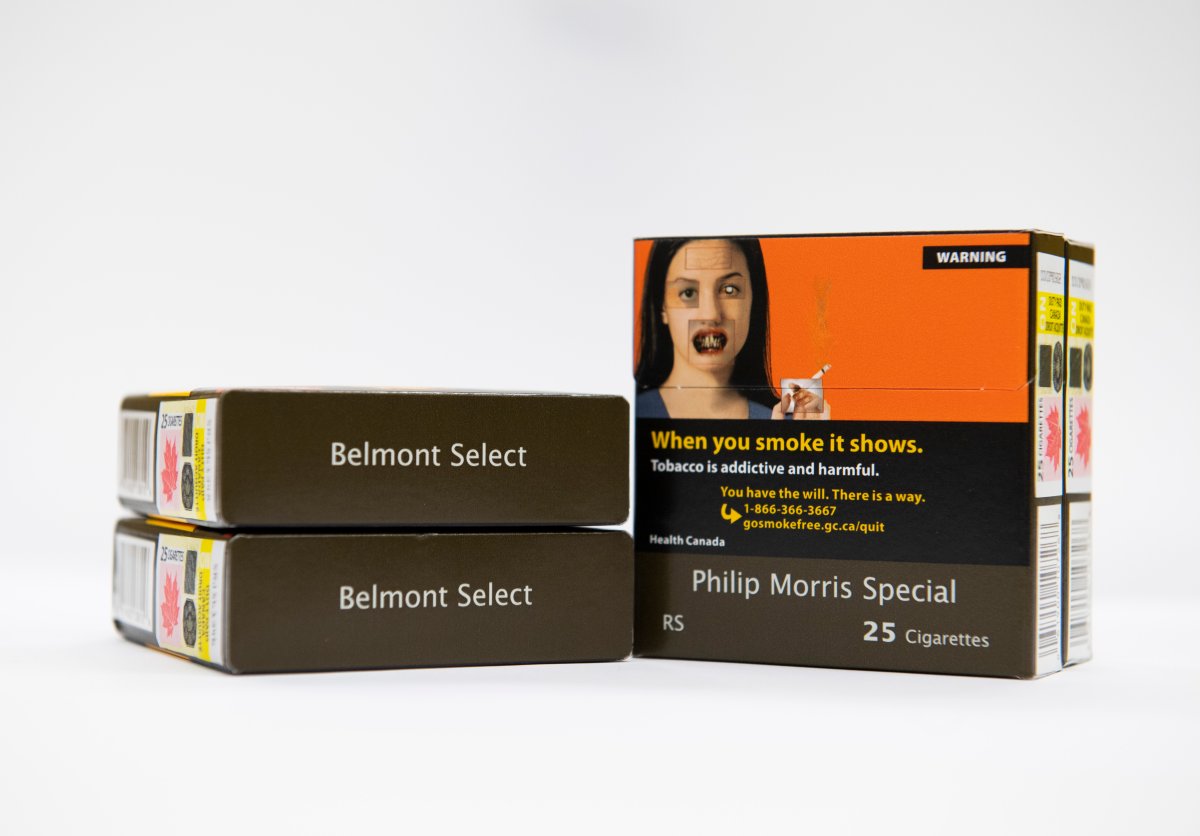Smokers will soon see their cigarette packs stripped of logos and distinctive designs as federal rules make drab brown the default colour for tobacco brands next week.

Plain-packaged cigarettes have started to pop up on shelves as the tobacco industry prepares for Health Canada‘s regulations to take effect on Nov. 9, after which retailers will have a 90-day window to offload their remaining inventory.
All packaging will feature the same brown base colour, basic grey text and minimalist layout under the new requirements. The measures will also standardize the size and appearance of cigarettes, cigars and other products inside the packages.
Health experts and advocates say the policy positions Canada at the forefront of a global push to curb the appeal of cigarette brands, particularly among youth, and eliminate packages as pocket-sized promotions for Big Tobacco.
Rob Cunningham, a senior policy analyst at the Canadian Cancer Society, lauded Canada’s plain-packaging regulations as “the best in the world,” having learned from the examples of at least 13 other countries that have adopted similar measures.
Cunningham adds that Canada is leading the charge in eliminating extra-long and “slim” cigarettes, which tend to be marketed to women.

In 2021, slide-and-shell packages will become mandatory in Canada, providing a wider surface area that will display the largest health warnings in the world, he said.
“This measure is going to have an important difference, especially over time,” said Cunningham. “We will have kids who will grow up not exposed to branded packages.”

Get breaking National news
As regulators have cracked down on many forms of tobacco advertising, packages have become powerful branding tools to appeal to consumers, said University of Waterloo psychology professor Geoffrey Fong.
“The package designs (are) really amazingly glitzy and very attractive, especially to kids,” said Fong, the founder and chief principal investigator of the International Tobacco Control Policy Evaluation Project.
“What we’ve found is that plain packaging has tremendous effects on reducing the appeal of these deadly products.”
Fong said cigarette packages are designed to deceive consumers into thinking some brands are less harmful than others. For example, he said, studies indicate that cigarette packages with light colours and white space are perceived to have lower health risks than dark-toned products.
Fong said there’s evidence suggesting that plain packaging reduces these misconceptions, while making health warnings more salient by eliminating eye-catching distractions.
In his own research, Fong found that less than 29 per cent of Canadian smokers were in favour of plain packaging — a lower level of support than any other “endgame” tobacco measure tested in the 2016 survey.
He interprets this result not as opposition to the policy, but uncertainty about what it will entail, projecting that approval will rise as smokers acclimate to the new norm.

Tobacco manufacturers expect there will be a learning curve as consumers adjust to the new look, and in some cases, new names of their preferred brands.
For example, Belmont Silver will be known as Belmont Select under the new rules for brand names prohibiting references to colours or filter characteristics.
Jeff Gaulin, director of external affairs at Rothmans, Benson & Hedges, said the company has been working to ensure that retailers are aware of the changes by updating the names in its ordering system months in advance, as well as setting up a website for consumers to find out what products will be affected.
“I think things will go pretty smoothly,” said Gaulin. “That said, there will still be some hiccups… There may be shortages, but if there are, I think they’ll be very, very minimal.”
While he said Rothmans, Benson & Hedges doesn’t oppose plain packaging for conventional cigarettes, Imperial Tobacco Canada objects to the policy on several fronts, said head of regulatory affairs Eric Gagnon.
“You’re changing the entire supply chain,” said Gagnon. “It’s not like you just turn a key on and off. You need to change all your artwork, all your equipment, retool all your machines, so obviously, it’s very costly and a very complex operation.”
Gagnon contends that plain packaging doesn’t work and boosts the illicit sale of tobacco products.
Other industry members have mounted similar criticisms, which the World Health Organization has described as “baseless” and “not supported by the evidence.”

Gagnon declined to comment on whether Imperial Tobacco is considering challenging the regulations in court, but Cunningham of the Canadian Cancer Society notes that tobacco companies have been fighting plain packaging in Canada since public-health officials first put forward proposals in 1994.
In the 25 years since, Cunningham said efforts have been bolstered by a growing body of evidence suggesting these policies have had an impact in other countries, and Canada may be next.
“All of these countries wouldn’t be doing this in the face of strong opposition from the tobacco industry if it wouldn’t work,” he said. “It’s a highly effective measure, and that’s why they’ve opposed it for so long, and that’s why we place great emphasis on it.”







Comments